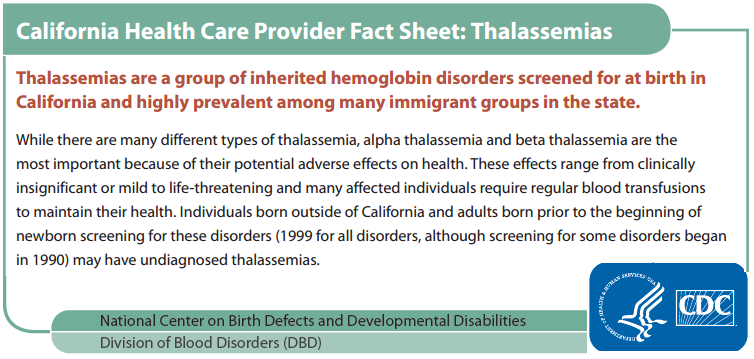Prevalence and Demographics: Worldwide
 Thalassemia occurs across the globe, but is most prevalent among the following populations:
Thalassemia occurs across the globe, but is most prevalent among the following populations:
- Italians
- Greeks
- Cypriots, Sardinians (Mediterranean region)
- Southeast Asians (Vietnamese, Laotians, Thais, Singaporeans, Filipinos, Cambodians, Malaysians, Burmese, and Indonesians)
- Chinese
- Indians
- Bahrainis
- Egyptians
- Africans
- Middle Easterners (Iranians, Pakistanis, and Saudi Arabians)
- Transcaucasians (Georgians, Armenians, and Azerbaijanis)
- Romanians
- Bulgarians
- Albanians
There are two main types of thalassemia trait: alpha thalassemia trait and beta thalassemia trait. Individuals who have beta thalassemia trait have one normal beta globin gene and one that is altered such that it makes little or no beta globin. There are subtypes of alpha thalassemia trait. Individuals with 'silent alpha thalassemia trait' are missing one alpha globin gene. When two alpha globin genes are missing, an individual is said to have 'alpha thalassemia trait'. This can occur in two different ways. The 'cis' type of alpha thalassemia trait occurs when the two genes are missing from the same chromosome. This type is most common in those of Southeast Asian, Chinese, or Mediterranean ancestry. The 'trans' type of alpha thalassemia trait occurs when the two genes are missing from different chromosomes. This type is most common in African Americans.
Thalassemia trait is generally not thought to cause health problems, although women with the trait may be more likely to develop anemia of pregnancy than women without the trait. Obstetricians sometimes treat this with folate supplementation. Most types of thalassemia traits cause the red blood cells to be smaller in size than usual, a condition called microcytosis. Sometimes this is inaccurately referred to as 'low blood'. Since iron deficiency is the most common cause of microcytosis, doctors sometimes mistakenly prescribe iron supplementation to individuals with thalassemia trait. Therefore, before prescribing iron supplements, doctors should rule out thalassemia trait and/or perform lab tests to evaluate iron levels. A person with thalassemia trait can also be iron deficient, but if he or she is not, iron supplements may result in excess body iron. Excessive iron can deposit in many areas of the body, causing organ damage in the long-term.
Updated 1/21/2015













